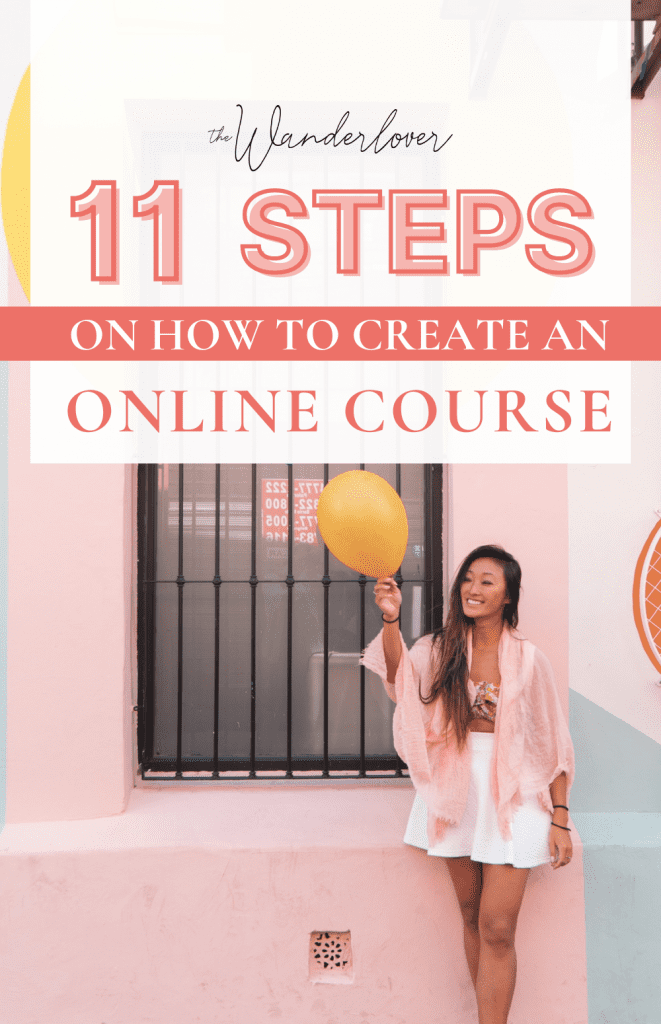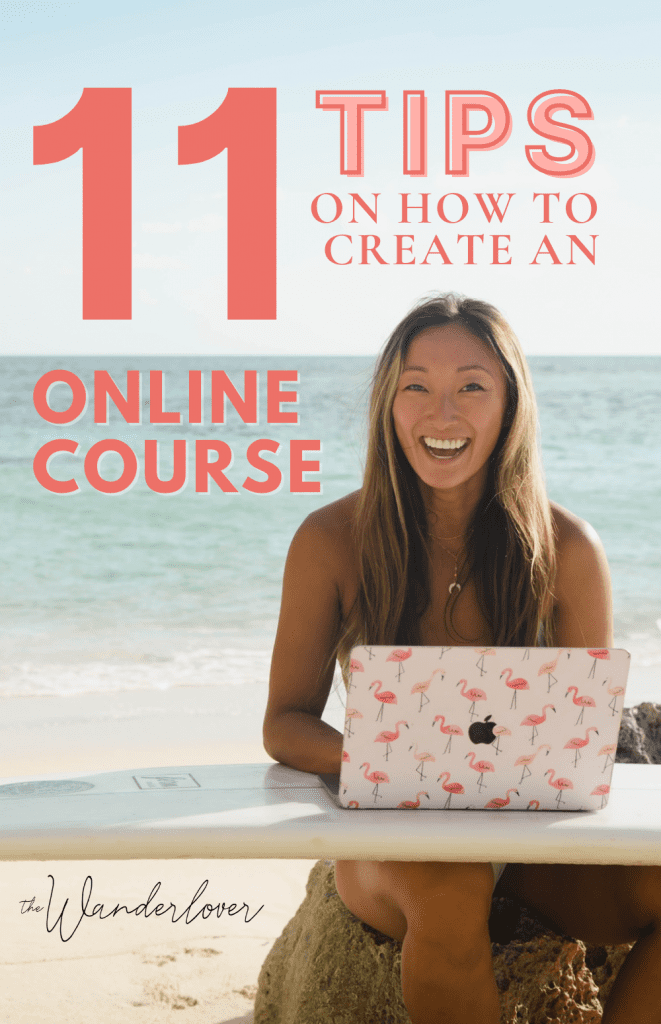As the e-learning space continues to grow, it should come as no surprise that one of the best ways to make money online is by creating an online course. In today’s world, people can now study at their own pace from anywhere in the world. For freelancers and other creatives, this is a tried and tested opportunity. In this blog, I provide a step by step guide on how to create an online course with useful tips and advice to get you started.
You are going to want ThriveCart!
Before we get into this, there is one really important thing you are going to need. An e-learning platform.
This is what you build your course in, allows people to navigate modules, make payments and progress through your courses. Thrivecart does all of this with hands down the best sales funnel builder on the market, AND an entire e-learning platform all wrapped into a one-time fee. It’s simply a no-brainer and is the exact tool I have used to build the Wanderlover into a 6 figure business.
Check out my guide to ThriveCart here
Why should you create an online course?
One of the best reasons for creating an online course is the time freedom it provides. Once your course is up and running, you won’t need to spend much time on it. Essentially, you can sit back and watch the money roll in. Most importantly, you can get paid from anywhere in the world, even when you are not connected to the internet. Through creating an online course, you can sustain your location freedom for years to come.
Another thing I like about the online course model is that you can reach a pretty big audience. Market your course internationally to grow your audience and encourage enrollments. Creating an online course also makes you and your services more credible. This will automatically increase your authority in the market, enhancing the brand, boosting your reputation and directing more traffic to your website.
So at a glance,
Some of the benefits of creating an online course are :
- Passive income potential: With an online course, you can create content once and sell it multiple times, providing a passive income stream.
- Flexibility: Online courses can be accessed by students at any time, allowing them to learn at their own pace and on their own schedule.
- Scalability: Online courses can be easily scaled and accessed by a large number of students, allowing you to reach a wider audience and potentially increase your income.
- Increased expertise: Creating an online course can help you solidify your knowledge and expertise on a particular topic, and can also be a great way to share that knowledge with others.
- Personal and professional growth: Creating an online course can be a rewarding and fulfilling experience, and can also help you to grow and develop both personally and professionally.
So with that said, let’s get into some of the steps involved and tips for creating your own online course.
Finding topics and validating ideas
Once you’ve decided to create an online course, choosing a topic is the next step.Think about the industry you work in and the skills you have. You’ll also need to consider your audience. Think about the questions they ask along with the comments, shares and likes you receive on social media
Solve a problem
A great starting point is to find a common problem that you can solve. Perhaps you receive questions about how to succeed in a particular industry or how to become an influencer. Once you’ve identified a ‘common problem’ decide how your course will resolve it. This is a good template to use for any course as it helps develop a clear and effective marketing plan.
Identify and define an audience
Now that you have a topic, you’ll need to find potential students. Before jumping into things, communicate with your audience and undertake some market research. You don’t want to spend time creating an online course that no one is interested in do you? Didn’t think so.
Ask people if they are likely to enroll. Connect with your current clients and post in Facebook groups and on other social media platforms. The Wanderlover Business Academy was created because I was fully booked out for private coaching. From this, I was able to identify an audience who wanted to start an online business and my idea sprang from there.
Some of my top tips for finding, and engaging your audience are :
Leverage your existing network:
Reach out to your current audience, such as your email subscribers, social media followers, or clients, and let them know about your course. They are likely to be interested in what you have to offer and may be willing to spread the word to their own networks.
Utilize social media:
Share your course on social media platforms, such as Facebook, Twitter, and LinkedIn, and use relevant hashtags to reach a wider audience. You can also consider running paid ads on these platforms to target specific demographics.
Collaborate with influencers or industry experts:
Partner with influencers or industry experts in your field who have a large following. They can help promote your online course to their audience and give it credibility.
Use SEO to optimize your website:
Make sure that your website and course landing page are SEO optimized so that they rank highly in search results. This will help potential students find your course when they are searching for related topics.
Offer a free preview or trial:
Consider offering a free preview or trial of your online course to give potential students a taste of what they can expect. This can help build interest and drive enrollment.
Utilize paid advertising:
Consider running paid ads on platforms like Google AdWords or Facebook Ads to target specific demographics and reach a larger audience.
Host a webinar or live event:
Hosting a webinar or live event can be a great way to promote your course and give potential students a chance to ask questions and interact with you.
By utilizing a combination of these tactics, you can effectively reach and engage an audience for your online course.
Define learning outcomes
Once you have your topic and audience defined, it’s time to decide what your students are going to get from your online course.
Your students will want to know exactly what they are getting. They are not going to be willing to part with their money, if they are not even sure what they will get from your course. That’s why you need to define your learning outcomes before building your course.
Once you have a better idea of who your audience are, ask yourself what they will learn. Compile a list and create clear, concise outcomes. Write statements like, “by the end of this course you will……..”. You can then use this list to build your landing page and advertise the course.
These learning outcomes will also help you create the content you need as each outcome will have content associated with it. It will also help you filter out unnecessary content as you will throw out anything that doesn’t have a learning outcome directly linked to it.
Structure your online course modules
A good course should take your clients on an A to B journey, where point A is the starting point. For my course, point A was that feeling of confusion and not really knowing the business side of creativity. Point B is what your clients will achieve upon completing the course.
With The Wanderlover Business Academy, Point B is having the confidence and knowledge to run a successful business. In order to package your course, map out the steps that take your students from A to B. Your course journey should align with your learning outcomes.
The way you structure and design your course will ultimately determine how successful it becomes.
Start by mapping out the topics you want to cover in your course and organizing them into logical modules or sections. Consider your target audience and what they need to learn in order to achieve their goals.
Identify milestones
Identifying milestones will help you break your content into sections that are achievable and rewarding for your students. Use your A-B journey and break it into smaller steps.
Say for example, you are planning a course on how to build and launch a website.
Your milestones might be:
- Get set up
- Develop 5 page website
- Launch your website
As you can see, defining your course milestones will help you define your modules, lessons and content.
When planning any project, you’ll also want to lay out some key milestones for yourself to keep you on track. Set yourself guidelines and actionable goals to ensure that you complete this course effectively and efficiently.
Plan your modules and lessons
Modules and lessons are arguably the most important elements of any online course. Consider the modules you’ll need in order to reach your learning outcomes and milestones as identified in the previous step. Each module should provide something new and insightful. Break your course modules into individual lessons. How will you teach your chosen topics? Slides, videos and screen shares are all popular options.
Using the example of a course on how to build and launch a website, the primary milestones we defined can be broken down further:
- Get set up
- Buy your domain domain
- Set up web hosting
- How to install wordpress
- Choose and install your wordpress theme
- Develop 5 page website
- How to create a page
- What 5 pages should you create first
- How to post a blog
- How to edit your menu
- How to change images
- Launch your website
- How to publish your content
- Submit your sitemap to google
- SEO tips and best practices
Now you are starting to get a great picture of the content you need to create for your course.
You’ll also want to think about additional resources and support options. Will you use emails or do you want to offer 1:1 tutoring sessions?
Create a community of like minded people where students can connect and support one another. This can be a private Facebook group or a group chat. It’s super important that your students feel supported throughout the course. Homework, workbooks and other useful information are all great ways to enhance your lessons.
Name your course and describe it
A good course name is succinct and tells your audience exactly what it is. Now you know what your course is all about, Write up a short description detailing the key takeaways and learning outcomes. Show the reader what they will gain from the course, using that A to B journey as inspiration. Focus on your clients needs and write a description that is both engaging and informative.
Decide your bonuses
Bonuses can make your course stand out and encourage more sign-ups. Choose incentives like regular Q&A sessions and access to a private Facebook community. With my course, I also offer a list of must-have apps, a content calendar and a 100k scaling strategy with a cheat sheet.
Recording and creating
Now that you’ve got the above sorted, it’s time to start creating. For me, this is the fun part. It’s the culmination of everything coming together. The best advice I can give is to just be yourself and enjoy it. After all, you are discussing all the things you are passionate about and sharing it with others. What’s not to love? Recording usually takes a few days depending on your setup and workflow.
- Create a script: Write out a detailed script or outline for each module, including the main points you want to cover and any examples or anecdotes you want to use. This will help you stay focused and ensure that you cover all of the important information.
- Set up your recording environment: Choose a quiet, well-lit location to record your course modules. Set up your microphone, camera, and any other equipment you will be using to ensure that the audio and video quality is high.
- Record your course modules: Follow your script or outline as you record each module. Take breaks as needed and try to relax and be yourself – your enthusiasm and personality can make a big difference in the quality of your course.
- Edit and polish your course modules: After you have recorded all of your modules, go back and listen to them carefully. Edit out any mistakes or pauses, and add any additional audio or visual elements as needed.
- Publish your course: Once you have finished editing and polishing your course modules, it’s time to publish them. This could involve uploading them to an online platform, such as Udemy or Teachable, or creating your own website to host the course. I recommend using a course building platform like Thrive Cart Learn which provides all the tools you need.
Price your course
When it comes to pricing, it really does depend on your individual situation and the course itself. If you are unsure whether you are charging too much or too little, remember you can always seek professional advice. At The Wanderlover Business Academy, we dedicate an entire module to pricing up your course.
If you are reading this and thinking of creating an online course, I’m going to assume you have some other products or services already available. So think about how this online course fits into your wider business model.
Things to consider:
- Is this course a freebie? A lead magnet that brings traffic to your other products or services.
- Do you want this to be it’s own passive income stream?
- Is this your primary income?
The value you associate to your course will depend heavily on questions like this and how you fit your new course into your business model.
Whatever you decide, be sure to have a payment plan option for your students and always display prices on the landing page.
Launch it
Once your course has been packaged, priced and recorded, it will be time to get it published. Exciting times! The most effective option is to choose a publishing platform like Thrive Cart Learn. These platforms help tie your course together by enabling you to create landing pages. They also offer useful marketing tools and accept payments from anywhere in the world. Other popular options include Kajabi and LearnWorlds. If you are unable to invest in a platform, you can also set up a Youtube email series. Just find a way that works for you and roll with it.
Get your course online and launch it. If you’re using a course building platform, then this step is fairly simple. Of course, once you’ve launched it you will need to sell it. That’s where a solid marketing plan comes in.
Marketing
Marketing is arguably the most important part of the process. In order to make money from your online course, you will need to reach out to your audience and generate leads. Make the most of your social media platforms to share and promote your course. Invest in Facebook ads, Google ads and press features. Collaborations and webinars are also great ways to advertise the course and increase your reach.
Now that you understand these basic steps, it’s time to get started. As daunting as it sounds, elearning is a great way to make money online while maintaining your chosen lifestyle. Although it takes a bit of ground work, building an online course is more than achievable. At The Business Academy, we show you exactly how to create an online course from building your brand to pricing and marketing. As long as you take the right steps, you will be making money in no time.
Share on Pinterest















